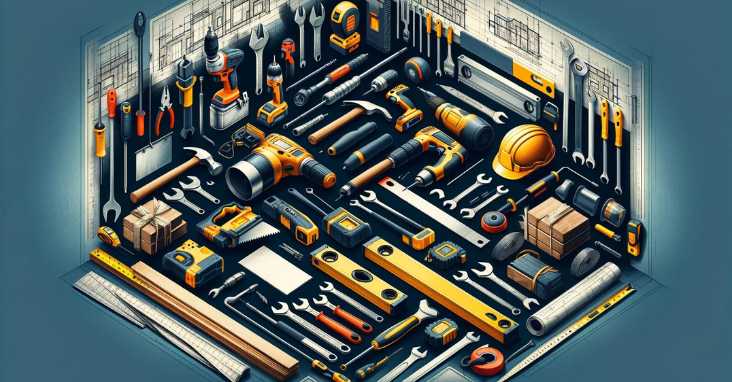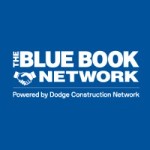What are the essential construction tools for building projects? Must-have tools: hammer, saw, drill, tape measure, level, wrench set, screwdriver set, ladder, safety gear, and utility knife for any building project.
Construction tools are essential for any building project, whether it’s a small home renovation or a large-scale commercial construction project. These construction tools are designed to help workers perform their jobs more efficiently and safely. From hand tools like hammers and screwdrivers to power tools like drills and saws, there are many different types of construction tools available to meet the needs of any project.

Hand tools are some of the most basic construction tools and include items like hammers, screwdrivers, wrenches, pliers, and more. These construction tools are typically used for tasks that require precision and control, such as installing screws or tightening bolts. Power tools, on the other hand, are designed to make construction tasks faster and easier. These construction tools are typically powered by electricity or battery and include items like drills, saws, sanders, and more.
Construction tools are not the only things needed on a construction site. Building materials, equipment, and safety gear are also essential. Building materials include items like lumber, concrete, drywall, and roofing materials. Equipment includes items like cranes, bulldozers, and excavators. Safety gear includes items like hard hats, safety glasses, and gloves. All of these items work together to ensure that construction workers can perform their jobs safely and efficiently.
Key Takeaways
- Construction tools come in many different types, including hand tools and power tools.
- Building materials, equipment, and safety gear are also essential for any construction project.
- Using the right construction tools and equipment can help workers perform their jobs more efficiently and safely.
Hand Tools
Hand tools are essential construction tools for any project. They are versatile and easy to use, making them a favorite among builders and DIY enthusiasts alike. Here are some of the most commonly used hand tools in construction:
Hammers and Mallets
Hammers and mallets are used for driving nails or breaking objects. They come in different sizes and shapes, with the most popular being the claw hammer. The claw hammer has a flat face for driving nails and a V-shaped claw for removing them. Mallets, on the other hand, are used for striking objects that require a softer touch. They are often made of rubber or wood.
Chisels and Punches
Chisels and punches are used for cutting and shaping wood or metal. Chisels have a sharp edge for cutting, while punches are used for making holes or indentations. They come in different sizes and shapes, with the most popular being the flat chisel and the center punch.
Screwdrivers and Nut Drivers
Screwdrivers and nut drivers are used for tightening or loosening screws and bolts. They come in different sizes and shapes, with the most popular being the Phillips and flathead screwdrivers. Nut drivers, on the other hand, are used for tightening or loosening nuts and bolts.
Pliers and Cutters
Pliers and cutters are used for gripping and cutting wires or other materials. They come in different sizes and shapes, with the most popular being the needle-nose pliers and the wire cutters. These construction tools are essential for any electrical work.
Measuring and Marking Tools
Measuring and marking tools are used for measuring and marking distances or angles. They come in different sizes and shapes, with the most popular being the tape measure and the square. These construction tools are essential for ensuring accurate measurements and cuts.
Saws and Cutting Tools
Saws and cutting tools are used for cutting wood, metal, or other materials. They come in different sizes and shapes, with the most popular being the hand saw and the hacksaw. These construction tools are essential for any construction project that involves cutting.
One external resource that provides more information on hand tools is Popular Mechanics. They provide a comprehensive guide on the best construction tools for different construction projects.
Power Tools
Power tools are essential construction tools for any project, making tasks faster and more efficient. They are powered by electricity, batteries, or compressed air, and they come in various types and sizes to match the specific needs of the job.
Drills and Drivers
Drills and drivers are versatile power tools that can be used for drilling holes, driving screws, and other fastening tasks. Cordless drills are popular due to their portability and convenience, and they are powered by rechargeable batteries. They come in different sizes and power ratings, and some models even have adjustable torque settings to match the task at hand. For heavier-duty tasks, a corded drill can provide more power and consistent performance.
Saws
Circular saws are commonly used construction tools for cutting wood, metal, and other materials. They come in different sizes and blade types to match the specific job requirements. Corded circular saws are typically more powerful than cordless models, but cordless saws offer greater mobility and convenience. Other types of saws used in construction include reciprocating saws, jigsaws, and miter saws.
Sanders and Polishers
Sanders and polishers are used to smooth out rough surfaces and prepare them for finishing. Belt sanders, orbital sanders, and random orbital sanders are some of the most commonly used types of sanders in construction. Polishers are used to buff and shine surfaces, and they come in different sizes and shapes to match the specific job requirements.
Mixers and Vibrators
Mixers and vibrators are used for concrete and cement-related tasks. Concrete mixers are used to mix cement, sand, and water to create concrete, while vibrators are used to remove air bubbles from the concrete and ensure a smooth finish. Air compressors are often used to power these construction tools, and they come in different sizes and power ratings to match the specific needs of the job.
To learn more about power tools and their uses in construction, check out this resource.
Construction Equipment
Construction equipment is essential for any construction project, big or small. From heavy machinery to lifting and support equipment, and transport and conveyance tools, construction tools and equipment helps to facilitate the construction process. In this section, we will explore the various types of construction equipment and their uses.
Heavy Machinery
Heavy machinery is a crucial part of any construction project. Bulldozers, excavators, and other heavy machinery are used to clear land, dig foundations, and move large amounts of dirt and debris. These machines are powerful and can handle tough jobs with ease. They are also versatile and can be used for a variety of tasks, making them an essential tool for any construction project.
Lifting and Support
Lifting and support equipment is necessary for construction projects that involve building structures that require support. Ladders, for example, are used to reach high places and work on elevated areas. They come in different sizes and shapes, making them suitable for various tasks. Additionally, cranes and hoists are used to lift heavy materials and equipment to higher levels.
Transport and Conveyance
Transport and conveyance equipment are used to move materials and equipment around the construction site. Wheelbarrows, for example, are commonly used to transport small amounts of materials such as dirt, gravel, and sand. They are easy to maneuver and can be used in tight spaces. Additionally, trucks and trailers are used to transport larger amounts of materials and equipment from one location to another.
It is essential to use the appropriate construction equipment for each task to ensure the safety of workers and the success of the project. For more information on construction equipment, check out this link.
Building Materials
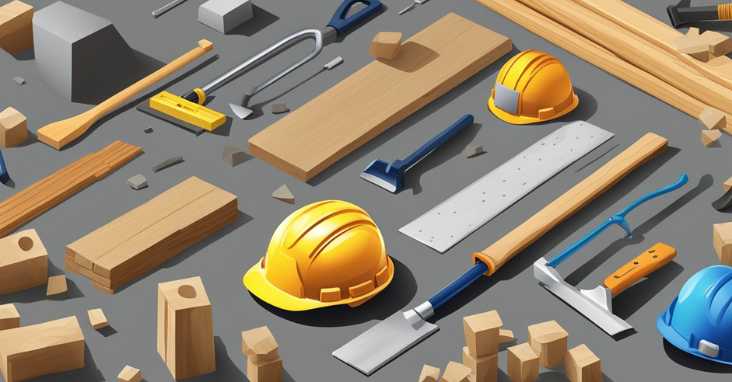
Building materials are the essential components used in construction projects. These materials can range from simple items like nails and bolts to more complex items like bricks and concrete. In this section, we will discuss two main categories of building materials: masonry and concrete, and wood and metal fasteners.
Masonry and Concrete
Masonry and concrete are popular building materials used in construction projects. Bricks, concrete blocks, and other masonry products are used to create walls, foundations, and other structures. Concrete is a versatile material that can be molded into different shapes and sizes to suit various construction needs.
One of the essential components of concrete is soil, which is used to create the cement that binds the concrete together. Soil is a natural resource that can be found in different parts of the world. In addition, concrete is reinforced with steel bars or mesh to provide additional strength.
To learn more about masonry and concrete, check out this link.
Wood and Metal Fasteners
Wood and metal fasteners are used to join two or more pieces of wood or metal together. Nails, nuts, and bolts are the most commonly used fasteners in construction projects. Nails are used to secure wood to wood, while nuts and bolts are used to connect metal parts.
In addition, wood and metal screws are also used to join wood and metal together. Screws provide a stronger and more secure connection than nails and bolts.
To learn more about wood and metal fasteners, check out this link.
Safety and Protection
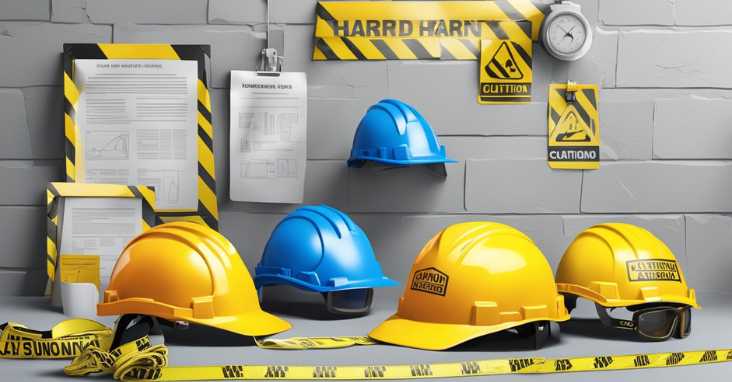
Personal Protective Equipment
Construction sites can be hazardous places, and it is essential to protect oneself from potential dangers. Personal Protective Equipment (PPE) is a crucial aspect of any construction project. PPE helps to prevent injuries and accidents by providing a barrier between the worker and the hazardous conditions.
The most common types of PPE used on a construction site include gloves, safety glasses, helmets, and rubber boots. Gloves are essential for protecting the hands from cuts, punctures, and other injuries. Safety glasses protect the eyes from flying debris, dust, and other materials. Helmets protect the head from falling objects, and rubber boots protect the feet from sharp objects and electrical hazards.
It is important to select the appropriate PPE for the specific task and to ensure that it fits correctly. Ill-fitting PPE can be uncomfortable and may not provide adequate protection.
Site Safety
In addition to PPE, site safety is critical to preventing accidents and injuries on a construction site. Site safety involves identifying potential hazards and taking steps to eliminate or reduce the risk of injury.
Some common site safety measures include:
- Regular safety inspections to identify potential hazards
- Clear signage to indicate potential hazards and safety procedures
- Proper training for all workers on site safety procedures
- Adequate lighting to ensure visibility in all areas of the site
- Proper storage of materials to prevent tripping hazards
- Adequate fall protection equipment for workers who are working at heights
It is important to prioritize site safety and to ensure that all workers are aware of the potential hazards and safety procedures on the construction site.
For more information on site safety and personal protective equipment, visit the Occupational Safety and Health Administration (OSHA) website. OSHA is a federal agency that sets standards for workplace safety and provides resources and training to help employers and workers ensure a safe work environment.
Measuring and Leveling

Accurate measurement and leveling are crucial for any construction project. Without proper tools, it can be difficult to ensure that everything is aligned and in the correct position. Here are some essential construction tools for measuring and leveling:
Levels and Plumb Bobs
Levels are used to ensure that a surface is horizontal or vertical. They come in various sizes and shapes, including bubble levels, laser levels, and digital levels. Plumb bobs are used to ensure that a surface is perfectly vertical. They consist of a weight on a string and are often used in conjunction with a level.
When selecting a level or plumb bob, it is important to choose one that is appropriate for the task at hand. A bubble level may be sufficient for simple projects, but a laser level may be necessary for more complex projects.
Measuring Wheels and Tapes
Measuring wheels and tapes are used to measure distances. Measuring wheels are ideal for measuring long distances, such as the length of a room or the distance between two points on a construction site. Measuring tapes are more versatile and can be used for measuring both long and short distances.
When selecting a measuring wheel or tape, it is important to choose one that is durable and accurate. Look for a tape or wheel that is easy to read and has a locking mechanism to ensure that the measurement stays in place.
It is essential to have high-quality measuring and leveling tools to ensure that a construction project is completed accurately and efficiently. For more information on measuring and leveling construction tools, visit The Home Depot’s Guide to Measuring and Layout Tools.
Worksite Setup
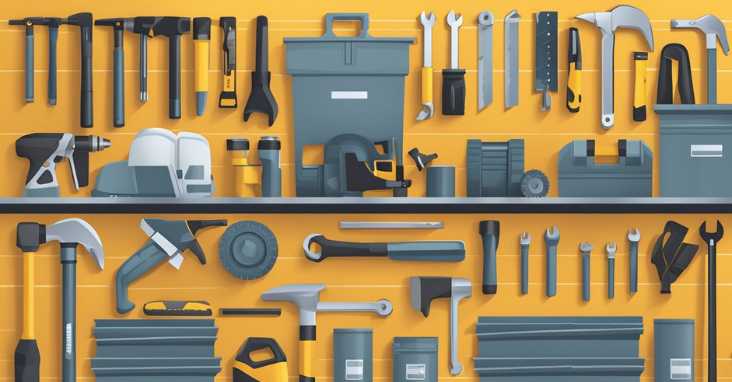
When setting up a construction site, it is crucial to have the right construction tools and equipment to ensure a smooth and efficient workflow. The worksite setup includes everything from work benches and sawhorses to tool storage and belts. Here are some essential tips for worksite setup:
Work Benches and Sawhorses
Work benches and sawhorses are fundamental construction tools and equipment for any construction site. They provide a stable work surface for cutting, drilling, and sanding. A sturdy workbench should be able to support heavy loads and withstand constant use. Sawhorses, on the other hand, are portable and can be easily moved around the site. They are ideal for cutting large pieces of wood or holding materials in place while working on them.
Tool Storage and Belts
Proper tool storage is essential for keeping the worksite organized and efficient. A well-organized tool belt is an excellent way to keep tools within reach while working. It can also help prevent tools from getting lost or misplaced. A tool belt should have enough pockets and compartments to hold all the necessary tools, including a trowel, hammer, and screwdrivers.
It is also essential to have a designated storage area for larger tools and equipment. A tool shed or cabinet can protect tools from the elements and prevent theft. It is recommended to invest in high-quality locks and security systems to keep the tools safe.
To learn more about worksite setup and construction tools, visit Construction World. They provide valuable information and resources for construction professionals.
Specialized Construction Tools
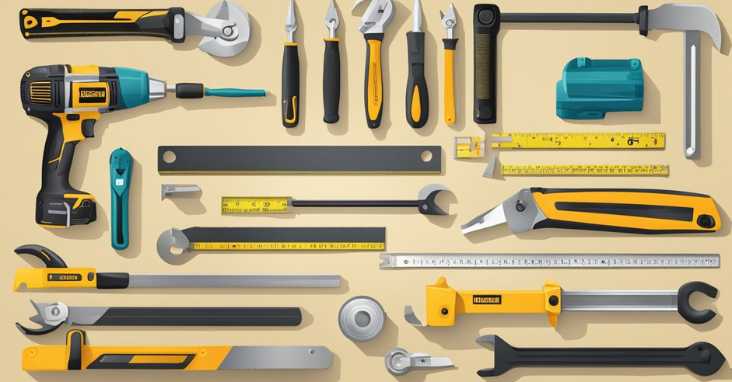
Specialized construction tools are essential when it comes to construction, specialized tools are essential for specific tasks. These tools are designed with a particular purpose in mind and can make a significant difference in the quality and efficiency of the work. In this section, we will discuss some of the specialized construction tools commonly used.
Tiling and Masonry
Tiling and masonry require precision and accuracy, and the right tools can make all the difference. A tile cutter is an essential tool for cutting and shaping tiles to fit specific areas. A float is used to spread and smooth out mortar or grout, while a trowel is used for applying mortar to bricks or blocks. A crowbar is also useful for removing tiles or bricks that need to be replaced.
Plastering and Finishing
Plastering and finishing require a range of tools to achieve a smooth and even finish. A hawk and trowel are used to apply plaster to walls, while a plastering float is used to smooth out the surface. A finishing trowel is then used to achieve a final smooth finish. Sandpaper is also used to smooth out any imperfections.
Gardening and Landscaping
Gardening and landscaping require a range of tools to maintain and shape outdoor spaces. A hoe is used to break up soil and remove weeds, while a shovel is used for digging and moving soil. A rake is used for leveling soil and removing debris. Garden shears are used for trimming bushes and hedges, while a pruning saw is used for cutting thicker branches.
When it comes to specialized tools, it’s essential to invest in high-quality products that will last. One external resource with high authority on this topic is Construction Equipment Guide. They offer a wide range of construction tools and equipment for sale, as well as reviews and ratings to help you make informed decisions.
Professional Considerations
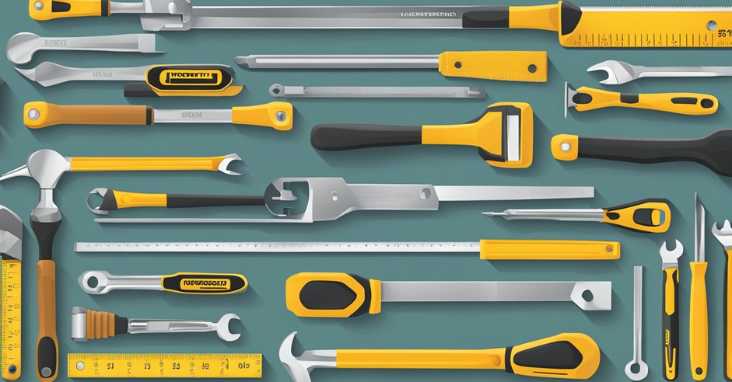
When it comes to construction tools, there are several professional considerations that carpenters, contractors, and other professionals need to keep in mind. The following subsections highlight some of the key considerations that are relevant to carpentry and woodworking, electrical and plumbing, as well as quality and durability.
Carpentry and Woodworking
For carpentry and woodworking, it is important to have tools that are precise, accurate, and reliable. Professionals in this field need tools that can handle various tasks, from cutting and shaping wood to joining pieces together. Some of the essential tools for carpentry and woodworking include saws, chisels, hammers, and drills. It is also important to have tools that are comfortable to use, as carpentry and woodworking often involve long hours of work.
One of the most important considerations for carpentry and woodworking tools is the quality of the materials used. High-quality materials, such as hardened steel, can ensure that the tools last longer and perform better. Professionals in this field should also consider the durability of the tools, as they will be subjected to heavy use.
Electrical and Plumbing
For electrical and plumbing work, professionals need tools that are safe, reliable, and easy to use. Some of the essential tools for electrical work include pliers, wire strippers, and voltage testers. For plumbing work, professionals need tools such as pipe wrenches, soldering irons, and drain augers. It is important to have tools that are specifically designed for electrical and plumbing work, as these tasks require specialized tools.
When it comes to electrical and plumbing tools, safety is a top priority. Professionals should ensure that their tools are properly insulated and grounded to prevent electrical shocks. It is also important to have tools that are easy to use, as electrical and plumbing work often involves working in tight spaces.
Quality and Durability
Regardless of the type of work being done, professionals need construction tools that are of high quality and durability. High-quality tools can ensure that the work is done efficiently and effectively, while durable tools can withstand heavy use and last for years. When choosing construction tools, professionals should look for tools that are made from high-quality materials and are designed to last.
One of the best ways to ensure that tools are of high quality and durability is to choose tools from reputable brands. These brands have a reputation for producing high-quality tools that are designed to last. Professionals should also consider the warranty and customer support offered by the manufacturer, as this can be an important factor in ensuring that the tools are reliable and durable.
In conclusion, professionals in the construction industry need to consider a variety of factors when choosing their construction tools. By focusing on quality, durability, and safety, professionals can ensure that they have the tools they need to get the job done right.
Frequently Asked Questions
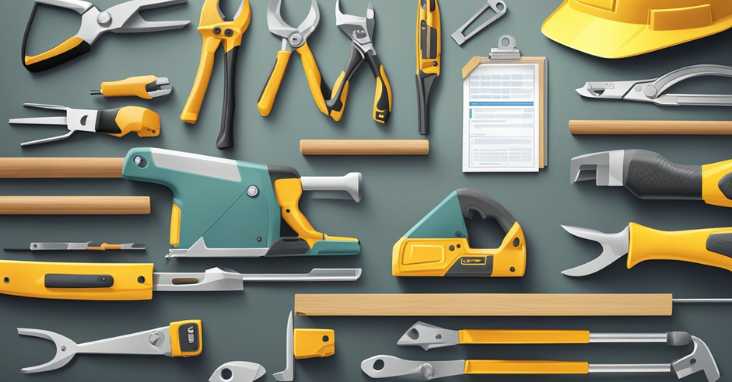
What are the essential tools every construction worker should have?
Every construction worker should have a set of basic hand tools that include a hammer, screwdrivers, pliers, wrenches, measuring tape, and a level. In addition, they should have power tools such as a drill, circular saw, jigsaw, and reciprocating saw. These tools are essential for a wide range of construction tasks.
How do I properly maintain my construction tools?
Proper maintenance is critical to ensure your tools last as long as possible. You should clean your tools regularly, store them in a dry place, and keep them lubricated. It’s also important to inspect your tools before and after each use to ensure they are in good working condition.
What safety precautions should be taken when using power tools on a construction site?
On a construction site, it’s important to follow all safety guidelines and wear appropriate personal protective equipment (PPE). This includes eye and ear protection, gloves, and a hard hat. It’s also important to ensure that the tools are properly grounded and that the work area is clear of any potential hazards.
What are the differences between hand tools and power tools in construction?
Hand tools are typically used for tasks that require precision and control, whereas power tools are used for tasks that require speed and efficiency. Power tools can also handle larger and more complex jobs than hand tools. However, power tools can be more dangerous if not used properly.
Can you list the top-rated brands for construction tools?
Some of the top-rated brands for construction tools include DeWalt, Milwaukee, Makita, Bosch, and Stanley. These brands are known for their durability, reliability, and performance.
What are some tips for choosing the right equipment for different construction tasks?
When choosing equipment for different construction tasks, it’s important to consider the size and scope of the project, the materials being used, and the skill level of the worker. It’s also important to consider the safety features of the equipment and to choose tools that are appropriate for the task at hand. For more information on choosing the right equipment, check out this guide from OSHA.

